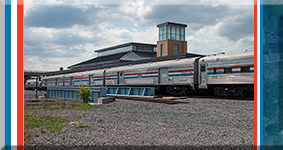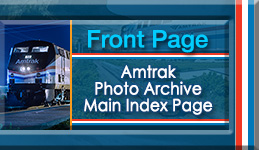 |
 |
 |
 |
| |
|
|
| |
As we begin visiting second of the three display cars, we see Amtrak welcoming in the new millennium with a display about the 2000's and some timetables. |
|
| |
|
|
| |
|
|
| |
Amtrak trains utilize "Head-End Power" to provide electricity to the train to power the lights, heat, air conditioning, etc. The red connectors you see here are located
on the ends of each car and engine so as to connect the power cables together. The air hoses underneath are also on the ends of each car and engine and are
used to move air through the braking system throughout the train.
|
|
| |
|
|
| |
|
|
| |
A display about working on the railroad! |
|
| |
|
|
| |
|
|
| |
Here's how electric trains get their power! Overhead catenary is used on the Northeast Corridor as well as on the Harrisburg line for Keystone Service trains. |
|
| |
|
|
| |
|
|
| |
Speed limit signs are used on the railroad in areas where a temporary speed restriction is in place for things like trackwork. In this example, the "80" is the speed
the train must slow down to and must be going at that speed when it sees the "S" sign. The "R" sign is used to let the crew know they can resume normal track
speed once the entire train has passed that sign.
|
|
| |
|
|
| |
|
|
| |
Amtrak has its own police department which does a fantastic job of keeping our nation's passenger railroad safe everyday! |
|
| |
|
|
| |
|
|
| |
Now this is one of the most popular parts of the Exhibit Train! As the sign says, "The Sound Of Amtrak" allows visitors to hear different types of train horns that
Amtrak has used over the years as well as see the different types of horns that were used on various pieces of Amtrak equipment.
|
|
| |
|
|
| |
|
|
| |
An early Amtrak drumhead along with information about the predecessor railroads that turned their passenger rail service over to Amtrak. |
|
| |
|
|
| |
|
|
| |
A display about different types of train stations in the Amtrak system. Also a mannequin dressed as a "Red Cap". These attendants assist passengers with their
luggage and direct them where to go when boarding and/or alighting from their trains at larger stations throughout the country.
|
|
| |
|
|
| |
|
|
| |
Operating Manuals along with some brake wheels are shown here. Look at that early radio! |
|
| |
|
|
| |
|
|
| |
A 1990's-era HO scale model of an Amtrak train. In this era, F40's were being replaced by P42's and would often be seen as the trailing unit lead by a P42 when
those locomotives were first being delivered to Amtrak by General Electric Transportation Systems in Erie, PA.
|
|
| |
|
|
| |
|
|
| |
A diesel locomotive control stand from a General Motors Diesel GP40TC. Think about the instrument cluster inside your car, only this is what the engineer sees
when operating a locomotive. The proper term is "operating" as a locomotive goes where the tracks go and thus is not "driven".
|
|
| |
|
|
| |
|
|
| |
An interactive signal light display is shown here. This is set up so you can switch the two signal lights here to read different signal aspects. The top signal, known
as a "searchlight" signal currently reads an "Approach" signal. The bottom signal, known as a "dwarf" signal shows a "Slow Approach" aspect. |
|
| |
|
|
| |
|
|
| |
A display of several HO scale models of Amtrak locomotives and passenger cars seen throughout the system. Next up, Display Car #10095! |
|
 |
 |
|
|
|
 |
 |
 |
    |